 |

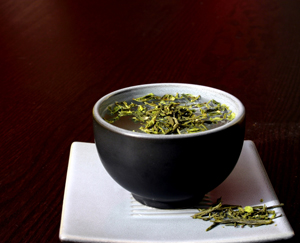 |
| Looks count: the beautiful leaves of this week’s tea selections brew into exquisitely delicious teas. Photo copyright Etan Lightstone. |
The Year of Great Tea:
Red & Green Company
Every time we turn around, it seems there are several new purveyors of gourmet teas. The lines are often beautifully packaged, but surprisingly, the tastes don’t bowl us over as we think they should. They are subtly fine, but not startlingly noteworthy.
We admit that when we first saw the wares of the Red & Green Company, we were suspicious. The packaging seemed too targeted to giftware buyers, and the company devoted as much space to selling beautiful earthenware teapots as to selling tea. How serious could this tea be?
Upon closer inspection, we found that the teas themselves look—and smell—particularly wonderful (they are simply beautiful to gaze upon, an aspect that our limited photography showcase below fails to capture) and create exquisite infusions. We kept returning to inhale the aromas as we would enjoy a great glass of wine.
These teas will be epiphanic to American tea-drinkers who have never understood why Asians drink tea without milk or sugar. Not only is the taste a special experience; when the leaves unfurl (use a glass pot or cup, if you have one), you actually see them as they were plucked from the tree! To celebrate the Chinese New Year, which began January 29 and traditionally launches fifteen days of festivities, we are drinking a different Red & Green Company tea each day. This is the healthiest and lowest-calorie celebration ever to be recommended by THE NIBBLE, so we suggest you join in.
With specialty teas available at a broad range of prices, why should you spend $23 or $24 on an ounce and a half of Red & Green’s teas? (Before it begins to sound like caviar, remember that tea weighs slightly more than feathers; an ounce goes a long way, and the leaves can be infused several times.) Are you paying for the authentic bamboo or shimmering-aluminum tube in which the teas are packaged, when a cardboard box would do?
Perhaps a wee bit goes to packaging, but this is exceptional-quality tea. You only use one teaspoon of leaves per cup, so think of fine tea as you’d think of fine wine: you get what you pay for. In fact, the canister of tea will last far longer than a bottle of wine. And, by the way, a cardboard box won’t do: airtight packaging is required to safeguard those precious leaves.
Challenging Choices
Perhaps the most daunting task for a tea-lover is deciding what to select from Red & Green’s current roster of 31 teas. When faced with a large number of choices, a normal reaction is to hunker down with the familiar rather than to set sail on a voyage of discovery. Adding to the challenge is that in person, each tea is better looking and more fragrant than the next. |
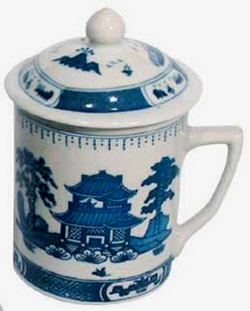
Cobalt blue and white porcelain, the most ubiquitous style of earthenware in the world, was introduced during the Ming Dynasty in the 14th century. We drink our tea in a covered porcelain mug similar to this one: at $5.99 each, we own ten of them! The lid keeps the tea (or coffee, soup, et al) warmer. Click here if you’d like to order these mugs. For a companion teapot, click here. |
Recognizing our own inability to make a decision under such circumstances, we asked proprietor Chongbin Zheng to select five teas that would provide an experienced tea-drinker with a truly memorable experience. Zheng, who grew up in Hangzhou, China near the famous tea regions, and who spends three months of the year there working directly with tea farmers, loves all of his “children”; but he chose five special teas that we are not likely to come across elsewhere.
If you want a refresher course in tea before reading about the Red & Green selections, you can click here to read an article in the archives of THE NIBBLE online magazine that reviews the different types of tea. We’ll discuss tea in general a bit more after we introduce the five teas:
| Tea |
Style |
Province |
| Aged Ti Kwan Yin |
Oolong |
Fujian Province |
Ti Kwan Yin is the Buddhist Iron Goddess of Compassion; these fine leaves come from 300-year-old tea trees in the Wuyi Mountain, an area known as the goddess’s home. A 76-year-old tea master, famous for his mastery of the processing of oolong, has conserved this tea over twelve years, using a carefully controlled aging and heating process to achieve a startling complex blend of herbs and tobacco leaf, plus some honey on the nose. The palate is more sweetly earthy and leaves, than it is smoky like a Lapsang Souchong or a Russian Caravan. The finish is very long. Every two years the tea is slow roasted for a brief period. At the end of 12 years, it will have been roasted for a total of 80 hours (a regular oolong is roasted for two hours at the time of plucking and then released to market). To prepare this rare tea, infuse with spring water at a temperature near boiling, and steep for one to two minutes for a light red infusion.
|

|
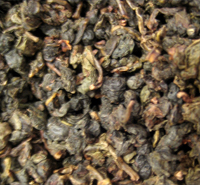
Most oolong teas are roasted for an
hour or so and released immediately
to market. This rare, aged tea is
smoked for a total of 80 hours, bit by
bit, over 12 years!
Aged Ti Kwan Yin has the highest of
cleansing properties of these teas.
It is excellent with a heavy meal; but
like great wines, it can demand
attention on its own, without the
distraction of food.
All tea-leaf photos by Melody Lan. |
| Imperial Pu-Er |
Pu-Er |
Yunnan Province |
This fine tea hails from the ancient tea trail area of Xi Song Banga Na, near the border of China and Viet Nam. It bears an “imperial” designation because it was used as a tribute in the Qing Court of the 19th century. Instead of being processed and released to market like most teas, the young harvested leaves are fermented and stored in dry storage for 15 years. This fully fermented tea has a taste with a rich body, vegetal mellowness and an earthy flavor (see detailed tasting notes in the box under the photo). These leaves are not glamorous—they look like the tea leaves most people are familiar with. But the flavor is anything but what most Westerners are acquainted with. To prepare, steep with boiled spring water for two minutes: it will create a familiar bright, cinnamon-red liquor. If you continue to steep, it becomes or dark red-brown, like most black teas.
|

|
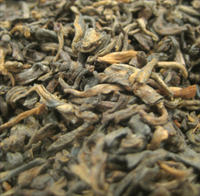
Pu-er is also sold in the medicine shops
of China, and is highly regarded for its medicinal qualities as a digestive and nerve stimulant. It is considered a
health drink as well as a delicious tea.
The fermentation shows itself as a faint peat aroma but the nose also contains a complex bouquet of dried and fresh herb notes—a nice layering of contrasts that repeats on the palate. There’s a flavor reminiscent of spirulina that will, indeed, remind you of a health drink. |
| Silver Needle |
White |
Fujian Province |
Truly the finest of all white teas, Silver Needle uses only the youngest, tenderest buds, picked in early spring and then processed into an elegant, long needle shape. The silvery-green color is representative of white teas: the young leaves and buds are covered in white down and are baby-soft to the touch. The scent is subtly aromatic, and the flavor is mild, sweet and fresh. The taste of white teas is delicate yet pronounced, with a long, balanced sweetness. They are very refreshing, naturally low in caffeine, and have the highest level of antioxidants of all teas. Infuse for four to five minutes in water that is well below boiling (boil the water and let it cool for a few minutes before pouring it over the tea leaves).
|

|
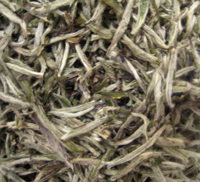
Of the five teas featured here, Silver Needle is the only variety we had tried before. This is an especially fine-quality Silver Needle.
Enjoy any delicate white tea with light foods or by itself.
White tea is a restful and contemplative tea: perfect for after yoga or meditation. |
| Tai Ping Hou Kwei |
Green |
An Huei Province |
From China’s Yellow Mountain area in An Huei province, this rare and beautiful tea is made from a large, flat leaf almost two inches long and reminiscent of a rare vegetable that would be served at a palace of haute cuisine. After the tea is picked, it is wrapped in gauze, which leaves a beautiful pattern on the leaves. Tai Ping Hou Kwei is the middle quality level between Monkey Ditch and Monkey Hill, two of the world’s rarest teas. Monkey Ditch, which has a red vein in the leaf (Tai Ping Hou Kwei has a red coloration, as you can see in the photo at the right), sold for $20,000 per 100 grams (3.5 ounces) in the October 2005 tea auction in Shanghai. It has an exceedingly fresh, sweet hay aroma and a grassy, green taste: the Sancerre of teas.
|

|
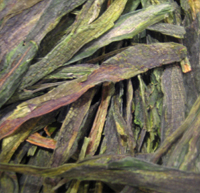
Drink Tai Ping Hou Kwei with meals,
like a fine wine.
It may be grassy like a Sancerre, but judging from the auction price, you can equate its costlier sibling, to a rare Burgundy—a case of Romanée Conti,
will cost $20,000 as well. |
| Wild Ti Kwan Yin |
Oolong |
Fujian Province |
Wild Ti Kwan Yin tea grows on rocky hillsides at elevations of 4,500 feet and higher, around the subtropical village of Xi Ping in Fujian province. The hilltops are shrouded in mist year-round, and the tea is only picked once a year (most teas are picked in the spring and the fall). This tea is not cultivated commercially but is picked in the wild during the spring. The leaf delivers a peerless intensity of aroma: a green and floral nose, fruitiness, notes of honey, great body, depth of flavor and a long finish. Steep in boiling spring water for one minute. When the leaves are fully unfurled, they looks as if they were plucked right off the tree: just gorgeous!
|

|
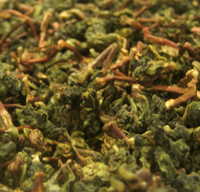
The exciting aromas and flavors of
this tea demand attention. A
golden infusion the color of champagne: drink
it for refreshment and for connoisseur’s
enjoyment.
|
Brew Your Teas in Glass Teapots To Fully Enjoy the Beauty Of These Leaves
Of course you can brew these teas in any pot or cup. But the best pots for full aesthetic enjoyment of the beauty of these beautiful leaves are glass. Jenaer Glas of Germany has been the fist name in glass teapots for as long as we remember—we have had ours since we were in college. Three styles are below; all have glass infuser baskets to hold the leaves. For more casual serving, we also enjoy the the plastic brewing IngenuiTea pot from Adagio—we have several. All are microwaveable and dishwasher-safe. Warming stands and votives are sold separately.
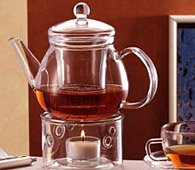 |
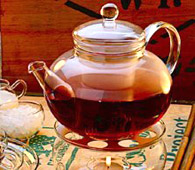 |
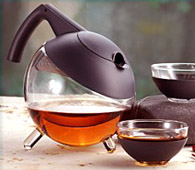 |
| Petit Teapot. This 15-ounce graceful pot provides one tea-lover with a cup and a refill. Click here for more information or to purchase. |
Mikado Teapot. At 21 ounces, this shapely teapot offers tea for two. Click here for more information or to purchase. |
Globo Teapot. This beauty updates the glass teapot for the new millennium. The 30-ounce capacity serves four.Click here for more information or to purchase. |
A Little Tea Learning
Tea is the world’s most popular beverage after water (although it’s a distant number five in the United States, and much of what we drink is bottled iced tea). Tea has been cultivated in China since prehistoric times. Like all food plants, it first grew wild; it was originally eaten as a vegetable.
All tea comes from the Camellia sinensis* plant, a warm-weather evergreen. As with wine grapes and coffee beans, local soil and climate produce widely varying flavors. That, and production techniques, are why there are many hundreds of varieties and styles of teas. Teas can be known by:
- Areas of origin: Assam, Ceylon, Darjeeling, etc.
- Flavoring and blending: Earl Grey (bergamot), English Breakfast (blend), Jasmine, Lapsang Souchong (smoked), etc.
- Grades: Hyson, Orange Pekoe, etc.
- Processing: Dragon Well, Gunpowder, Monkey Picked, Silver Needle, etc.
*Herbal teas do not come from the Camellia sinensis plant, but are an infusion of various leaves, roots, bark, seeds or flowers of other plants.
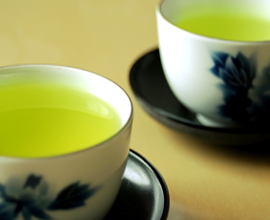
While white teas brew a very pale infusion, not all green teas produce a green liquor as the green tea above has. Some green teas produce the same reddish-brown liquor as oolong and black teas, due to soil, processing, and other factors. Photo copyright Simon Oxley. |
Whether tea is white, green, oolong or black depends on how the fresh leaves of the tea plant are processed after they are picked, and the level of contact with oxygen when the leaves are roasted. During oxidation, the tea leaves undergo natural chemical reactions that result in distinctive color and taste characteristics.
- Black tea is allowed to oxidize for two to four hours.
- Green tea is not oxidized at all; the leaves are steamed, rolled and dried.
- Oolong tea falls somewhere between green and black teas in that the leaves are only partially oxidized.
- White tea is not oxidized at all. It is plucked in the spring before the leaf buds unfurl; the buds are wilted in the shade, then gently dried in natural sunlight.
|
Thus, you can have a Darjeeling tea (leaves grown in the Darjeeling area of India) that is white, green, oolong or black: it all depends on when that tea plant in Darjeeling is picked and how the leaf is processed.
Pu-er is a special fermented tea made from a large leaf grown in certain areas of Yunnan province. It is priced according to its quality and age: it becomes more mellow and aromatic the older it gets. Pu-er can be aged for six to seven years; quality teas more than ten years old are collectors’ items. (In an auction at the 2005 Guangzhou International Tea Expo, 250 grams (8.8 ounces) of old pu-er sold for $22,300, and some high-end tea clubs charge $123.00 for one tiny serving.
Tea Notes
- Fine white and green teas should be used within six months. Buy only what you will drink in that time period. Keep the tea stored in airtight containers in the refrigerator.
- To brew loose teas, add one rounded teaspoon per 6-ounce cup. If you like strong tea, you can add more.
- Most teas should not be brewed with boiling water (212°F). Delicate, downy-leafed white teas, and green teas made from young leaves, taste best when brewed at temperatures around 185°F. Black, oolong and pu-er teas are best brewed at temperatures around 203° to 208°F.
- Length of steeping is a matter of individual taste. Tea steeped for 1-1/2
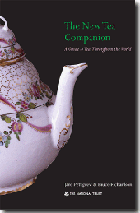 to 2-1/2 minutes has a lighter color and more subtle flavor nuances. Longer steeping (three to five minutes) results in a deeper color and a more pronounced flavor. With the fresh, fine teas above, shorter steeping is recommended. For all teas, over-steeping will result in bitterness from the tannins. to 2-1/2 minutes has a lighter color and more subtle flavor nuances. Longer steeping (three to five minutes) results in a deeper color and a more pronounced flavor. With the fresh, fine teas above, shorter steeping is recommended. For all teas, over-steeping will result in bitterness from the tannins.
- For more tea tips, click here for articles in THE NIBBLE’s online magazine, and consider purchasing one of the top books like The New Tea Companion (at right), the latest definitive guide to teas throughout the world. We’ve made other book recommendations below.
|
There’s no shortage of information about the health benefits of tea’s substantial concentration of antioxidants. While white tea has the highest concentration, then green, oolong and black (the less oxidation, the more antioxidants are retained in the tea), all teas are packed full of them. You should drink eight cups a day to get your maximum “scientific” share of them.
Drink up! We wish you a healthy new year—and by the way, it’s the year of the dog!
—Karen Hochman
Updated January 2008
FORWARD THIS NIBBLE to your tea-loving friends.
RED & GREEN COMPANY
Fine Chinese Teas
- Aged Ti Kwan Yin (Oolong)
1.75 Ounces, Bamboo Cylinder
$12.00
- Imperial Pu-Er (Pu-Er)
1.5 Ounces, Bamboo Cylinder
$12.00
- Silver Needle (White)
1.5 Ounces, Silver Cylinder
$14.00
- Tai Ping Hou Kwei (Green)
1.5 Ounces, Silver Cylinder
$10.00
- Wild Ti Kwan Yin (Oolong)
1.5 Ounces, Bamboo Cylinder
$14.00
Purchase online* at SpringBuds.com
or telephone
1.415.626.1375 during standard business hours, Pacific Time.
*Prices and product availability are verified at publication but are subject to change. Shipping is additional. THE NIBBLE does not sell products; these items are offered by a third party with whom we have no financial or other relationship. This link to purchase is provided as a reader convenience.
Learn more about tea in the Tea Section of THE NIBBLE online magazine...
...and check out the books about tea and the Japanese teapots below. |
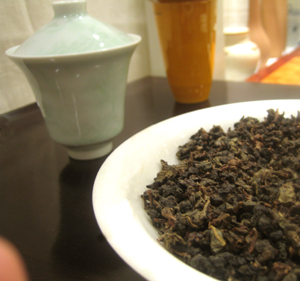
A bowl of Aged Ti Kwan Yin. Photo by Melody Lan. Below, aluminum canister that holds Silver Needle and Tai Ping Hou Kwei teas (shown with another of Red & Green's 31 teas).
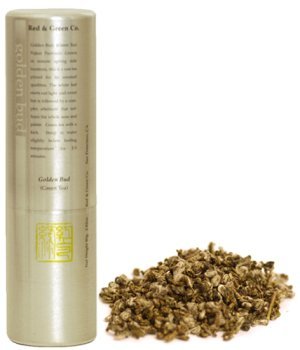
|
Health Food
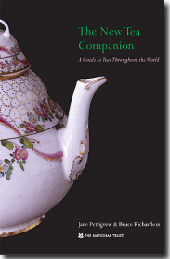 |
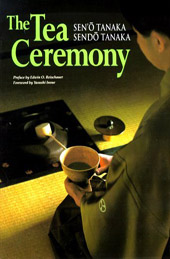 |
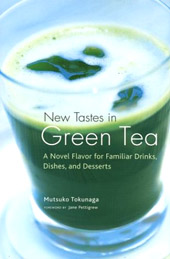 |
| The New Tea Companion, by Jane Pettigrew and Bruce Wilson.This latest definitive guide to teas throughout the world is beautifully illustrated with detailed information and brewing instructions for more than 80 teas. It also includes all the newest information about tea and health, tea production, tea blending and tea hospitality. If you have ever wondered about the time and temperature to brew your teas— white, green, black or oolong—this is the book for you. Click here for more information or to purchase. |
The Tea Ceremony, by Edwin O. Reishchauer (foreword), Sen'O Tanaka, Yasushi Inoue and Dendo Tanaka. Tea seeds were brought to Japan from China during the T'ang dynasty (618-907 A.D.), when cultural interchange between the two countries reached a peak. The Japanese developed the fascinating and graceful art of the tea ceremony. This book may inspire you to study it yourself. Click here for more information or to purchase. |
New Tastes in Green Tea: Novel Flavor For Familiar Drinks, Dishes, And Deserts, by Jane Pettigrew (foreword), Mutsuko Tokunaga and Yoko Toyozaki. This book includes an exciting fusion recipe collection, from drinks like Green Tea Latte, Matcha Smoothie, and Iced Matcha au Lait to pastas, sides and confections. It will open up a world of culinary delights—infused with healthy tea. Click here for more information or to purchase. |
Charming Teapots For Your Fine Tea
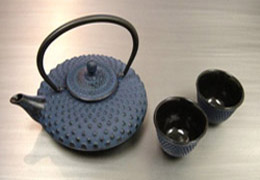 |
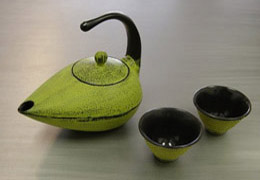 |
| Japanese Cast Iron Tea Pot and Cups. This beautiful cast iron tea-pot set in Mochi Blue is a
tranquil
accompaniment to your teas. The tea pot, 7 inches in diameter by 2.75 inches high, holds 20 ounces. The cast
iron
keeps the tea hot. A removable stainless steel infusing basket means easy clean-up. Click here for more information or to purchase. |
Nezumi Lime Green Tea Pot and Cups. If you prefer the vibrant to the subtle, this lime green cast iron tea-pot set will brighten your mood as you sip your tea. Almond-shaped, 7.5" long and 5.5 inches wide, it holds 20 ounces of tea and holds the leaves in a removable infusing basket. With two matching cups. Click here for more information or to purchase. |
FOR ADDITIONAL INFORMATION, special offers,
contests, opinion surveys, THE NIBBLE
prior issues archive, product gift-finder and more,
visit TheNibble.com.
| Do you have friends who would enjoy THE NIBBLE? Click here to send them an invitation to sign up for their own copy. |
© Copyright 2004-2006 Lifestyle Direct, Inc. All rights
reserved. All information contained herein is subject to change at any time
without notice. All details must be directly confirmed with manufacturers, service
establishments and other third parties. The material in this newsletter may not
be reproduced, distributed, transmitted, cached, or otherwise used, except with
the prior written permission of Lifestyle Direct, Inc.
|
 |
|
 |
























